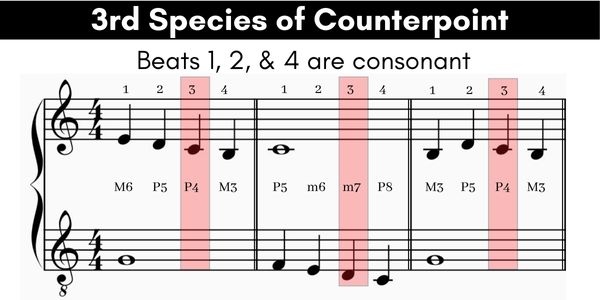If you do not know about cantus firmus, 1st species counterpoint, or 2nd species counterpoint, check out the following articles first:
In 3rd species counterpoint the counterpoint moves in quarter note durations against the cantus firmus in whole notes.

Rules of 3rd Species Counterpoint
- If 5 quarter notes are ascending or descending the following must be observed:
- The first note must be consonant
- The second note may be dissonant
- The third note must be consonant
- The fourth note may be dissonant if the fifth is consonant
Consonant and dissonant beats
Here is an example of having the 1st and 3rd beats consonant and the 2nd and 4th can be either consonant or dissonant. Remember perfect 4th (perfect 11ths) are considered dissonant.

Here is an example where the 3rd beat is allowed to be dissonant as long as the other beats are consonant.

Another acceptable consonant dissonant movement is the cambiata or “exchanged note.” This is where the 2nd beat is dissonant and then you leap away to a consonant and resolve the leap in the opposite direction.

The next to last measure in 3rd Species Counterpoint
If the cantus firmus is in the lower part, then the second to last note must be an interval of a Major 6th that then moves by contrary motion to the octave.

If the cantus firmus is in the upper part, place a minor 3rd at the second to last note and resolve to a unison. Alternatively, you can use a minor 10th and resolve to the octave.

Using sharps and flats and examples
Sometimes it is necessary to use sharps and flats in order to avoid tritones (augmented 4th/diminished 5th). Here are some examples from Joseph Fux. Even in these examples there are issues that might be flagged as “less good” or “incorrect”. In my experience, writing counterpoint (or any composition) there is no “perfect” answer. You should try to learn the principles behind the theory or exercise but don’t be bound by them. Use your ear. And if something just sounds strange or breaks the rules, don’t fret. One of the beauties of music is that you can always write more.

The two issues I flagged in the example above are “too many notes going in the same direction in a row” and “large repetitive leaps”. The first issue of too many notes going in the same direction also outlines a major 9th (d to e) which is dissonant. The second issue is the octave leap of c to c and back to c again. And then the leaps of a to d repeated. Typically, in counterpoint we try to avoid repeated patterns and sequences (at least for now). Is the above example “wrong”? No. There are countless ways this example could have been written, and in the end if it sounds good, it is good. Here is what this short counterpoint sounds like.
Here is an example of using flats and sharps in the same exercise.

Here is what this example sounds like. I love the mixing of B and B-flat.
Lastly, here is an example where Fux accepts lots of leaps. Usually, counterpoint favors smooth voice leading – meaning steps are preferred to skips. But as you can see in the example below, there are many leaps and some are “unresolved” by stepping back in the opposite direction.

It’s easy to get wrapped up in all the rules of counterpoint, but examples like the one above shows that you can be lenient and to just enjoy writing rather than being so strict.

Leave a Reply